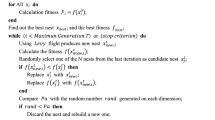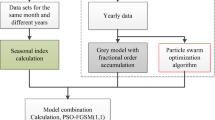Abstract
With the rapid development of China's economy, wind resource development has important practical significance for alleviating environmental pollution problems in China. As China's clean energy province and western economic center, Sichuan's wind power industry is gradually starting from the 13th Five-Year Plan. Considering the volatility and periodic characteristics of wind power generation in Sichuan Province, this paper proposes an optimized seasonal grey model based on Aquila Optimizer. The proposed model selects dummy variables 1 and 0 to represent seasonal factors and perform seasonal classification of the sample data. According to the classification sequence, this paper constructs the grey forecasting model with optimized initial and background values by Aquila Optimizer. The proposed model predicts wind power generation in Sichuan Province and verifies its validity and rationality by comparing results with other selected methods. In training and test groups, the performance results of the proposed model are better. The mean absolute percentage error is 3.44% and 12.34%, and the root mean square error is 0.86% and 4.33%. Finally, this paper further provides policy advice and planning based on the prediction results for the future development of Sichuan Province's clean energy industry during the 14th Five-Year Plan period.












Similar content being viewed by others
Explore related subjects
Discover the latest articles, news and stories from top researchers in related subjects.Data availability
Data will be made available on reasonable request.
Abbreviations
- AO:
-
Aquila Optimizer
- AO-SGM(1,1):
-
Seasonal grey model(1,1) based on Aquila Optimizer
- ARIMA:
-
Autoregressive integrated moving average model
- DGM(1,1):
-
Discrete grey model(1,1)
- GM(1,1):
-
Grey model(1,1)
- HPF-GM(1,1):
-
Grey model(1,1) based on Hodrick–Prescott filter
- IAGO:
-
Inverse acumulative generation
- MAPE:
-
Mean absolute percentage error
- PSO:
-
Particle swarm optimization
- PSO-SGM(1,1):
-
Seasonal grey model(1,1) based on particle swarm optimization
- RMSE:
-
Root mean square error
- SARIMA:
-
Seasonal autoregressive integrated moving average model
- SCGM(1,1):
-
Seasonal cycle grey model(1,1)
- 1-AGO:
-
First-order accumulation generation
References
Abualigah L, Yousri D, Abd Elaziz M, Ewees AA, Al-qaness MAA, Gandomi AH (2021) Aquila optimizer: a novel meta-heuristic optimization algorithm. Comput Ind Eng 157:107250
Arlt J, Trcka P (2021) Automatic SARIMA modeling and forecast accuracy. Commun Stat Simul Comput 50(10):2949–2970
Benitez RBC, Paredes RBC, Lodewijks G, Nabais JL (2013) Damp trend Grey model forecasting method for airline industry. Expert Syst Appl 40(12):4915–4921
Chen J, Li G, Wu D, Shen S (2019) Forecasting seasonal tourism demand using a multiseries structural time series method. J Travel Res 58(1):92–103
Cong J, Ren M, Xie S, Wang P (2019) Predicting seasonal influenza based on SARIMA Model, in Mainland China from 2005 to 2018. Int J Environ Res Public Health 16(23):4760
Cui H, Lui Z (2021) Spatial-temporal pattern and influencing factors of the urban green development efficiency in Jing-Jin-Ji Region of China. Pol J Environ Stud 30(2):1079–1093
Deng J (1982) Control problem of grey systems. Syst Control Lett 1(5):288–294
Ding S, Tao Z, Hu J (2022) Forecasting the economic indices of the high-tech industries in China using the grey multivariable convolution model. Appl Soft Comput 126:109301
Du P, Guo J, Sun S, Wang S, Wu J (2022) A novel two-stage seasonal grey model for residential electricity consumption forecasting. Energy 258:124664
Egrioglu E, Yolcu U, Bas E, Dalar AZ (2019) Median-Pi artificial neural network for forecasting. Neural Comput Appl 31(1):307–316
Hamzaçebi C, Es HA, Cakmak R (2019) Forecasting of Turkey’s monthly electricity demand by seasonal artificial neural network. Neural Comput Appl 31:2217–2231
Hu Y (2020) Energy demand forecasting using a novel remnant GM(1,1) model. Soft Comput 24(18):13903–13912
Huang H, Tao Z, Liu J, Cheng J, Chen H (2021) Exploiting fractional accumulation and background value optimization in multivariate interval grey prediction model and its application. Eng Appl Artif Intell 104:104360
Jiang P, Li R, Liu N, Gao Y (2020) A novel composite electricity demand forecasting framework by data processing and optimized support vector machine. Appl Energy 260:114243
Jiang J, Wu W, Li Q, Zhang Y (2021) A PSO algorithm-based seasonal nonlinear grey Bernoulli model with fractional order accumulation for forecasting quarterly hydropower generation. J Intell Fuzzy Syst 40(1):507–519
Karimi T, Hojati A (2020) Designing a medical rule model system by using rough-grey modeling. Grey Syst Theory Appl 10(4):513–527
Li N, Wang J, Wu L, Bentley Y (2021) Predicting monthly natural gas production in China using a novel grey seasonal model with particle swarm optimization. Energy 215:119118
Liao K, Xu Y, Yin M, Chen Z (2020) A virtual filter approach for wind energy conversion systems for mitigating power system frequency fluctuations. IEEE Trans Sustain Energy 11(3):1268–1277
Liu L, Wu L (2021) Forecasting the renewable energy consumption of the European countries by an adjacent non-homogeneous grey model. Appl Math Model 89:1932–1948
Luo X, Yan X, Chen Y, Yue M, Li J (2020) The prediction of shale gas well production rate based on grey system theory dynamic model GM(1, N). J Pet Explor Prod Technol 10(8):3601–3607
Mao M, Chirwa EC (2006) Application of grey model GM(1,1) to vehicle fatality risk estimation. Technol Forecast Soc Chang 73(5):588–605
Mehrjoo M, Jozani MJ, Pawlak M (2020) Wind turbine power curve modeling for reliable power prediction using monotonic regression. Renew Energy 147:214–222
Meng Z, Liu X, Yin K, Li X, Guo X (2021) Forecasting China’s energy intensity by using an improved DVCGM(1, N) model considering the hysteresis effect. Grey Syst Theory Appl 11(3):372–393
NDRC (2016). The “13th Five-Year” Plan for Economic and Social Development of the People's Republic of China (2016–2020). http://www.gov.cn/xinwen/2016-03/17/content_5054992. htm
NDRC, 2021. The 14th Five-Year Plan (2021–2025) for National Economic and Social Development and the Long-Range Objectives Through the Year 2035. https://www.gov.cn/ xinwen/2021–03/13/content_5592681.htm
Pfeffermann D, Morry M (1995) Estimation of the variances of X-11 ARIMA seasonally adjusted estimators for a multiplicative decomposition and heteroscedastic variances. Int J Forecast 11:271–283
Qian W, Wang J (2020) An improved seasonal GM(1,1) model based on the HP filter for forecasting wind power generation in China. Energy 209:118499
Qiu H, Zhao H, Xiang H, Ou R, Yi J, Hu L, Zhu H, Ye M (2021) Forecasting the incidence of mumps in Chongqing based on a SARIMA model. BMC Public Health 21(1):373
Sahin U (2021) Future of renewable energy consumption in France, Germany, Italy, Spain, Turkey and UK by 2030 using optimized fractional nonlinear grey Bernoulli model. Sustain Prod Consum 25:1–14
Shan H, Qin M, Zhang L, Meng Z, Peng P (2023) The annual sales forecast for a chinese auto parts manufacturer based on IGM(1,1). J Grey Syst 35(1):113–129
Sivhugwana KS, Ranganai E (2020) Intelligent techniques, harmonically coupled and SARIMA models in forecasting solar radiation data: a hybridisation approach. J Energy Southern Afr 31(3):14–37
Sui A, Qian W (2022) Intelligent grey forecasting model based on periodic aggregation generating operator and its application in forecasting clean energy. Expert Syst 39(3):12868
Tong M, Dong J, Luo X, Yin D, Duan H (2022) Coal consumption forecasting using an optimized grey model: the case of the world’s top three coal consumers. Energy 242:122786
Trull O, Garcia-Diaz JC, Troncoso A (2020) Initialization methods for multiple seasonal holt-winters forecasting models. Mathematics 8(2):268
Turkovska O, Castro G, Klingler M, Nitsch F, Regner P, Soterroni AC, Schmidt J (2021) Land-use impacts of Brazilian wind power expansion. Environ Res Lett 16(2):024010
Wang J, Du P (2021) Quarterly PM2.5 prediction using a novel seasonal grey model and its further application in health effects and economic loss assessment: evidences from Shanghai and Tianjin, China. Nat Hazards 107(1):889–909
Wang Y, Lu J (2020) Improvement and application of GM(1,1) model based on multivariable dynamic optimization. J Syst Eng Electron 31(3):593–601
Wang H, Zhang Z (2022) Forecasting CO2 emissions using a novel grey bernoulli model: a case of Shaanxi Province in China. Int J Environ Res Public Health 19(9):4953
Wang Y, Dang Y, Li Y, Liu S (2010) An approach to increase prediction precision of GM(1,1) model based on optimization of the initial condition. Expert Syst Appl 37(8):5640–5644
Wang J, Ma X, Wu J, Dong Y (2012) Optimization models based on GM(1,1) and seasonal fluctuation for electricity demand forecasting. Int J Electr Power Energy Syst 43(1):109–117
Wang Z, Li Q, Pei L (2017) Grey forecasting method of quarterly hydropower production in China based on a data grouping approach. Appl Math Model 51:302–316
Wang Z, Li Q, Pei L (2018) A seasonal GM(1,1) model for forecasting the electricity consumption of the primary economic sectors. Energy 154:522–534
Wang H, Wang Y, Wu D (2022) A new seasonal cycle GM(1,1) model and its application in railway passenger volume forecasting. Grey Syst Theory Appl 12(2):293–317
Wu L, Zhao H (2019) Discrete grey model with the weighted accumulation. Soft Comput 23(23):12873–12881
Wu L, Li N, Zhao T (2019) Using the seasonal FGM(1,1) model to predict the air quality indicators in Xingtai and Handan. Environ Sci Pollut Res 26(14):14683–14688
Wu W, Pang H, Zheng C, Xie W, Liu C (2021) Predictive analysis of quarterly electricity consumption via a novel seasonal fractional nonhomogeneous discrete grey model: a case of Hubei in China. Energy 229:120714
Xie W, Liu C, Wu W (2023) A novel fractional grey system model with non-singular exponential kernel for forecasting enrollments. Expert Syst Appl 219:119652
Xiong P, Huang S, Peng M, Wu X (2020) Examination and prediction of fog and haze pollution using a multi-variable grey model based on interval number sequences. Appl Math Model 77:1531–1544
Ye L, Xie N, Hu A (2021) A novel time-delay multivariate grey model for impact analysis of CO2 emissions from China’s transportation sectors. Appl Math Model 91:493–507
Ye J, Xu Z, Gou X (2022) An adaptive Grey-Markov model based on parameters self-optimization with application to passenger flow volume prediction. Expert Syst Appl 202:117302
Yousuf MU, Al-Bahadly I, Avci E (2021) A modified GM(1,1) model to accurately predict wind speed. Sustain Energy Technol Assess 43:100905
Yuan Q, Yang D, Yang F, Saieed L, Wang K (2020) Green industry development in China: an index based assessment from perspectives of both current performance and historical effort. J Clean Prod 250:119457
Yun E, Hur J (2021) Probabilistic estimation model of power curve to enhance power output forecasting of wind generating resources. Energy 223:120000
Zeng B, Li C (2018) Improved multi-variable grey forecasting model with a dynamic background-value coefficient and its application. Comput Ind Eng 118:278–290
Funding
The research reported in this paper was partially supported by the National Natural Science Foundation of China (No. 71871106) and the Fundamental Research Funds for the Central Universities (Nos. JUSRP1809ZD; 2019JDZD06; JUSRP321016). the Key Project of Philosophy and Social Science Research in Universities of Jiangsu Province (No. 2018SJZDI051); the Major Projects of Philosophy and Social Science Research of Guizhou Province (No. 21GZZB32); Project of Chinese Academic Degrees and Graduate Education (No. 2020ZDB2); Major research project of the 14th Five-Year Plan for Higher Education Scientific Research of Jiangsu Higher Education Association (No. ZDGG02).
Author information
Authors and Affiliations
Contributions
All authors contributed to the study conception and design. Material preparation, data collection and analysis were performed by Youyang Ren, Lin Xia and Yuhong Wang. The first draft of the manuscript was written by Youyang Ren. All authors read and revised the final manuscript.
Corresponding author
Ethics declarations
Conflict of interest
The authors declare that they have no conflict of interest.
Ethical approval
This article does not contain any studies with human participants or animals performed by any of the authors.
Additional information
Publisher's Note
Springer Nature remains neutral with regard to jurisdictional claims in published maps and institutional affiliations.
Rights and permissions
Springer Nature or its licensor (e.g. a society or other partner) holds exclusive rights to this article under a publishing agreement with the author(s) or other rightsholder(s); author self-archiving of the accepted manuscript version of this article is solely governed by the terms of such publishing agreement and applicable law.
About this article
Cite this article
Ren, Y., Xia, L. & Wang, Y. An improved GM(1,1) forecasting model based on Aquila Optimizer for wind power generation in Sichuan Province. Soft Comput 28, 8785–8805 (2024). https://doi.org/10.1007/s00500-023-09007-w
Accepted:
Published:
Issue Date:
DOI: https://doi.org/10.1007/s00500-023-09007-w




